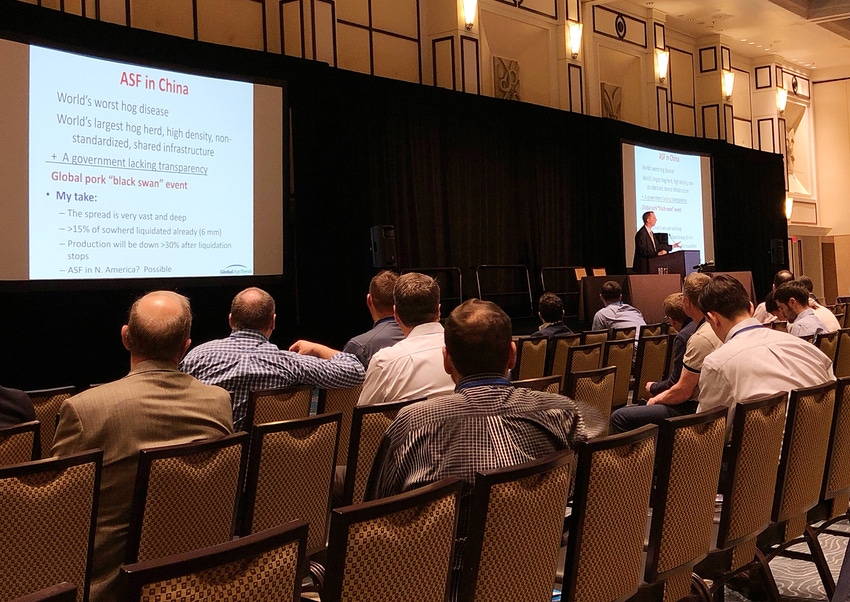China's pork production expected to be 30% lower after liquidation subsides.

Brett Stuart, president of Global AgriTrends, told the audience at the American Association of Swine Veterinarians (AASV) meeting being held this week in Orlando, Fla., that African swine fever (ASF) is a global “black swan” event for the pork industry.
Currently, there are three pillars of the ASF problem, he noted.
“You have the world’s worst hog disease in the world’s largest hog herd — it’s high density, it’s not standardized and it all shares infrastructure, whether it be trucks, feed mills or slaughter plants — and you have a government that is completely lacking in transparency that is trying to cover it up. So, there’s not a lot of reporting on it,” Stuart said.
Additionally, the spread of the disease is vast and deep, he said -- “way, way, way worse than we are hearing.”
Stuart, who has been talking to as many as possible about the disease, said a big commercial hog operation privately told him they have lost 95% of their sows.
In January, the Chinese government reported that the country’s sow herd was down 15% (6 million head) from the prior year.
Farms are having to liquidate hogs, he said, adding, “I think conservatively, production in China will be down 30% once the liquidation stops.”
This mass liquidation is oversupplying the marketplace in China. “Pork is cheap,” he said.
Stuart added that some packing plants can’t kill hogs fast enough. “They’re killing pigs and throwing them in the freezers just to hold for once they get through this glut, because they all know what’s coming: shortages. There will be a massive shortage,” he explained.
This is all “fantastic” for the U.S. industry, so long as it can avoid ASF here, he said.
“Your work’s not done,” he told the veterinarians in attendance.
In addition to China, the disease is currently present in the European Union, and Vietnam has reported 330 outbreaks in two-and-a-half weeks.
“It’s going to be in the Philippines, in Thailand, in Taiwan and Korea. Knock on wood that we can avoid it here,” Stuart said.
U.S. pork industry strategizing
At the AASV event, Bill Even, president of National Pork Board, discussed a collaboration the board currently has with the National Pork Producers Council, AASV and the Swine Health Information Center to keep the industry informed about ASF.
“You’ve got to be able to have a trusted source of information when you are dealing with something with this large of an impact,” Even said.
In fact, he said one misinformed tweet about Canada having ASF a few weeks ago sucked tens of millions of dollars out of the markets in minutes.
For the U.S. industry, he said the ASF priorities are prevention, early detection, rapid response and recovery.
If the disease does emerge, Even relayed that communication with consumers will be key. The industry is currently strategizing in this area.
A survey found that roughly half of the American public would want pork removed from grocery stores and restaurant menus if ASF hit the U.S. The number jumped to 60% when narrowed to the Hispanic population, Even noted.
The pork checkoff is prepared to quickly change course to focus on consumers, if necessary.
“We’re talking tens of millions of dollars that are going to have to go into a public communication confidence effort,” Even said.
About the Author(s)
You May Also Like





